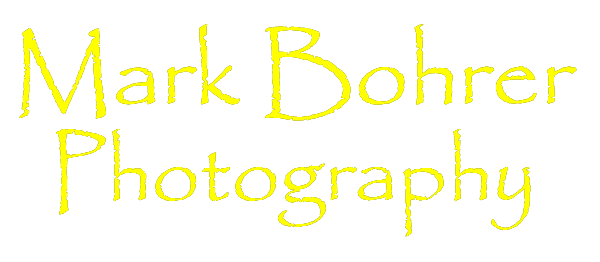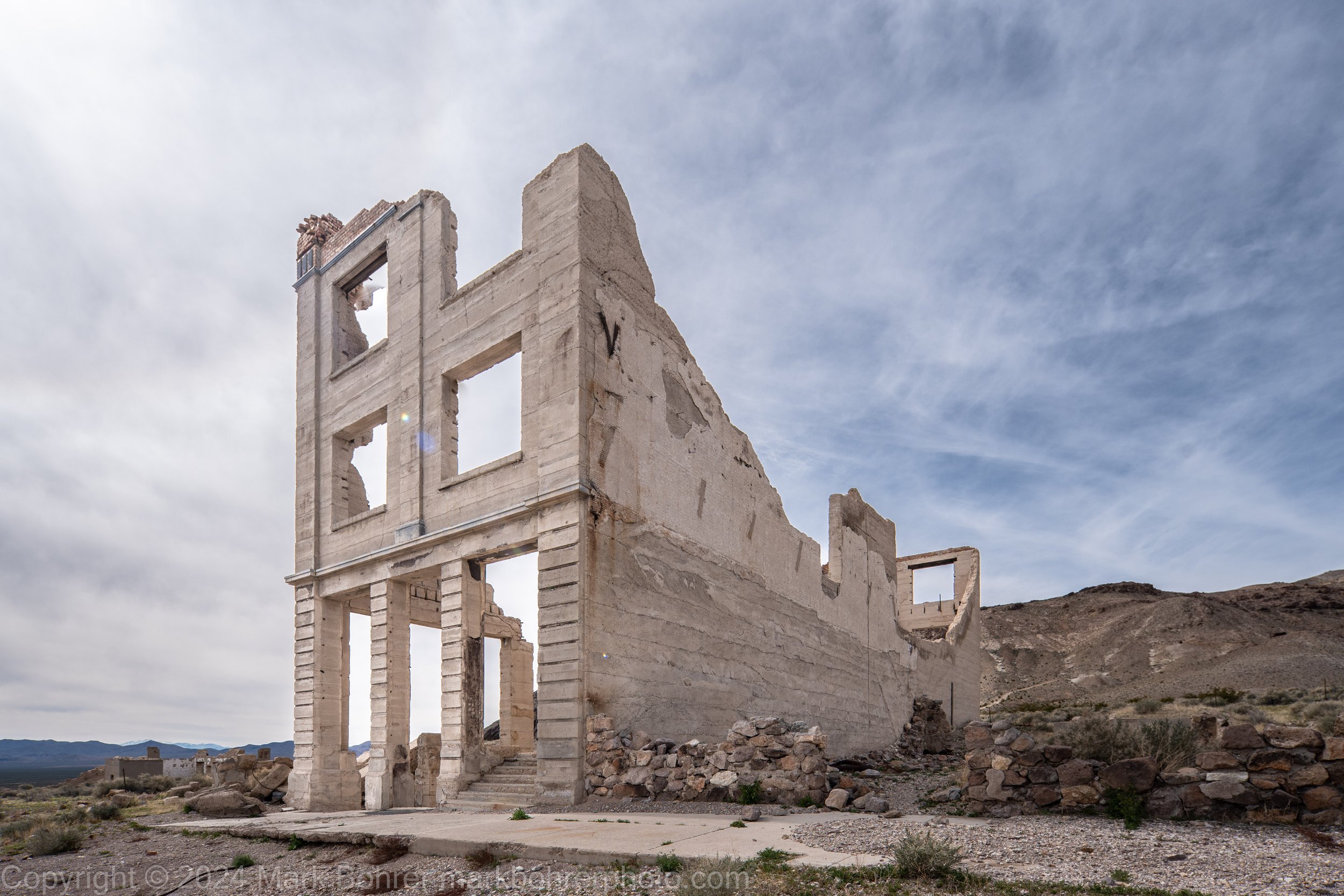Rhyolite After Dark
Shooting anything in daytime is quite different from lighting and shooting at night. Yes, there are obvious attractions you travel for, but it's a mood difference. You're an observer, a recorder of memories during the day. You see a tumbled-down ruin of a building, backed by dry desert mountains in harsh, bright sunlight, and that's what you capture.
Porter Brothers Store and moon
Night Moves
But at night, you're after a mood, a feeling. You either have one main light, the moon, or nothing but starlight, even though your eyes and brain work with whatever's there and try to make it visible enough to see. Moon or not, night’s lack of light lets you light a scene to match your creative vision. The feeling I’m after is usually mysterious drama. I want a viewer to ask questions: What's going on here? Is this a clandestine rendezvous? Is this what it looked like 100 years ago when miners swaggered into saloons, boasting about their latest strikes? Or are ghosts the only residents, whispering their secrets into the wind?
Capturing a viewer's interest usually involves making a building look lived in. At night, I want the interior to be lit. Maybe the exterior needs light to highlight an important detail, or to balance the composition. But either way, I want to tell a story in one shot. Maybe I just want you to be amazed at the grandeur and durability of old structures. Or maybe I want you to wonder what was happening in an old mining town at night, or what might be happening now.
I don't want to use lights just for the sake of using them, unless they're the subject of the picture. Then, with an especially compelling background like ruins at Chaco Canyon, I'll add light-painted alien balls of light next to 800+ year old structures, because I think the site needs a little humor. The vibe can be a little dark there.
At Rhyolite ghost town, I went for a different feel.
Rhyolite and Gold
Most American ghost towns started as mining towns. Some, like Bodie, California, are still largely intact. But none have the imposing, high-rise stone skeletons of Rhyolite, Nevada.
Cook Bank building
Old buildings and even wooden artifacts remain mostly untouched in desert dryness. The arid American west was also tectonically active in relatively recent geologic time, so deposits of precious metals were smeared in narrow north-south bands across the west from thrust faults.
But the deposits never lasted very long. After a few years the easy-to-find, rich ore was gone, and prospectors moved on, looking for the next big strike.
Frank "Shorty" Harris and Ernest Cross found a very rich gold strike on August 9, 1904, just a few miles south of what became the Rhyolite townsite. Word spread about their ore worth $665 / ton, and the rush was on.
As people flocked to the area, some smart eastern investors began promoting the town and staking out lots for Rhyolite. Soon there were 45 saloons, a schoolhouse, and the Porter store run by the enterprising Porter brothers, who supplied the nearly 10,000 people chasing gold around Rhyolite.
But like all booms, this one went bust, in 1907. There was a financial panic in the U.S. that year, and several financiers withdrew already shaky, overextended funding for very speculative mining ventures. Gold veins started petering out the same year. When gold was discovered in 1909 at the Pioneer Mine, half of Rhyolite's residents moved out to Pioneer. The rest waited for another closer strike that never came. The last Rhyolite resident died in 1924.
Tom Miller's Bottle House
But the town structures refused to die completely. Miner Tom Miller's bottle house with its glass bottle walls was re-roofed and restored by Paramount Studios for a 1925 movie, and N.C. Westmoreland rescued the train depot and converted it to a casino and museum in 1936. Rhyolite still remained empty of people, with some buildings later maintained by volunteers and the Beatty Improvement Association.
Last Supper sculpture by Albert Szukalski
Besides the ruins, Rhyolite has another attraction. The Goldwell Open Air Museum with its ghostly Last Supper sculpture is on the town's southern edge. The figures were cast in fiberglass covered in plaster, and their human "supports" removed to create the empty robes of figures at Christ's last supper. Sculptor Albert Szukalski thought his Da Vinci-inspired sculpture would remain standing only a couple years, but it's lasted for 60 so far.
The Best Laid Plans...
What caught my eye online was the relatively famous Cook Bank building with the yawning window openings in its 3-story front wall. I wanted to photograph that, with light coming from behind those windows. But when we got there that afternoon, I discovered the whole ruin was fenced off, and I could get no closer than 30 feet. I wouldn't be able to light it the way I wanted, but I worked around the fencing and took some daylight pictures. Then I went looking for another viewpoint for a night shot while we explored the ruins.
Cook Bank building
The former railroad depot and Tom Miller's bottle house were similarly fenced off, but I could walk right in to a mostly intact square stone chamber of the Overland Bank building. I looked around and visualized a possible composition showing that chamber with the Cook Bank in the background. After shooting a test shot to prove out the composition, I walked down the street to the Szukalski sculpture.
Overland Bank chamber with Cook Bank background
First off, how many different compositions of something this well-known and iconic can you shoot? I felt like I got mostly record shots, pictures just showing the thing as it is without telling a particular story
At that point, we left for an early dinner back in Beaty.
Night Shots... and Serendipity
Returning to the sculptures after dinner, I was slightly more inspired by background clouds and a diffraction sunstar behind a middle figure. Into dusk, I noticed some cloud patterns that accented the figures. And there was also a distant light at the vanishing point of the figure lineup.
Albert Szukalski’s Last Supper sculpture after dark
After I redeemed myself a little with evening sculpture pictures, I walked back into the Rhyolite townsite and noticed someone shooting pictures of the rising moon through the open front of the Porter Brothers store. I thought to myself, "What a great idea!" I knew getting moon detail well after sunset would be impossible - since the moon is reflecting sunlight, it's almost a full daylight exposure against the dim clouds and sky at dusk. That contrast range is way too much for any camera to handle. To help out, I set up a Luxli Fiddle LED panel light with a diffuser to throw light on the building front. That lit the building up, bringing its brightness closer to the moonlit cloudy sky. I chose a red color to contrast the sky's dark blue. I knew the nearly full moon would be a burned-out hole in the sky, but decided I could live with that.
Porter Brothers’ store in the moonlight
Get The Visualized Shot!
Then it was time to set up my visualized composition. After stumbling around a bit in the tumbled-down stones (tripping is a real hazard in dim light) and setting up tripod and camera, I took a couple test shots to check my exposure. Even with bright moonlight, I realized pretty quickly that relatively low ISO and resulting slow shutter speed would give me star trails along with the low picture noise I wanted. I didn't have a remote release and had to actually tap the shutter button, a sure way to induce camera wiggles and blurry shots if the shutter triggers right away. So I set the camera for delayed shutter release to avoid wiggles.
Since I was going to get them anyway, I decided to add to the star trails. So I set up the camera's Live View Composite mode. This magic mode takes a first shot using the manual lens aperture and shutter speed you choose, then captures follow-on shots of anything lit that changes and adds it to the picture - for as long as the total time you set, or until you interrupt it. The Panasonic Lumix S5 II and OM System OM-1 cameras both have this mode. I had the S5 II for this trip.
Overland Bank monolith and Cook Bank
For lights on this one, I put one Luxli Fiddle with diffuser inside the Overland Bank's chamber. I added a second Luxli Fiddle with Jeff McCrumb's Lanceli grid on it to focus red light on another part of the ruin. By coincidence, someone was exploring the Cook Bank by flashlight, lighting its ground floor up nicely in the background. I shot one ruined column as a central monolith with star trails rotating behind it. A light plane chose that moment to blink its lights through the sky, but it looked enough like a meteor trail that I didn’t worry about it.
Then I set up the lit chamber with the Cook Bank and railway station background. I could almost picture a visored bank manager counting the day's deposits by red firelight inside.
Overland Bank chamber with Cook Bank
I felt pretty safe, but there was a fair amount of evening car traffic in and out of the town, a few people walking by with flashlights, and more airplane traffic in the skies. So I finished up my last exposure, and we got out of there.
Shot Notes
I used a Panasonic Lumix S5 II for a couple reasons. Its 24MP full frame sensor resolution was enough for good picture detail, and its individual pixels were big enough to give me relatively low noise at high ISO settings. It also has that magic Live View Composite mode for star trails and lower overall noise.
A Canon EF 17mm f/4L TS-E lens adapted to L-mount helped me avoid tilting the camera up to shoot the Cook Bank ruin in daylight. I liked the tilted effect, though, so I shot with the camera tilted too. I used Lumix S 20-60mm f/3.5-5.6 and 18mm f/1.8 lenses for most daytime building shots and dusk sculpture pictures, respectively. I had a Rokinon SP 14mm f/2.4 manual focus lens for the night shots, where I wanted the widest field of view (FOV) and largest apertures I could get. As bright as the moon was, though, I didn't need large apertures. But the manual focus and wide FOV were very welcome.
Szukalski’s Last Supper and clouds
More Information
Quora, KC Armstrong (2019), Why is there so much gold found in the western part of North America? Retrieved from https://www.quora.com/Why-is-there-so-much-gold-found-on-the-western-part-of-North-America
The Street, Laura Rodini (May 19, 2023), What was the financial panic of 1907? Retrieved from https://www.thestreet.com/dictionary/panic-of-1907#:~:text=Over%20three%20weeks%20in%20October,even%20powerful%20in%20the%20process.
Federal Reserve, Jon R. Moen and Ellis W. Tallman (nd), The Panic of 1907. Retrieved from https://www.federalreservehistory.org/essays/panic-of-1907#:~:text=The%20Panic%20of%201907%20was,only%20by%20the%20Great%20Depression
Betsy Malloy (9/17/2020), Rhyolite Ghost Town in Nevada: The Complete Guide. Retrieved from https://www.tripsavvy.com/rhyolite-ghost-town-4069115#:~:text=Rhyolite%20grew%20as%20long%20as,was%20a%20deserted%20ghost%20town.
Kathy Weiser / Legends of America (August 2023), Rhyolite, Nevada -- Little More Than a Memory. Retrieved from https://www.legendsofamerica.com/nv-rhyolite/
Maria Cristina (Oct 23, 2021), Spooky Art: The Last Supper 1984 by Albert Szukalski (Interpretation and Analysis). Retrieved from https://maria-cristina.medium.com/spooky-art-the-last-supper-1984-by-albert-szukalski-interpretation-and-analysis-3934cf654d6#:~:text=Working%20from%20Da%20Vinci's%20original,white%20sheet%20draped%20over%20nothing.











